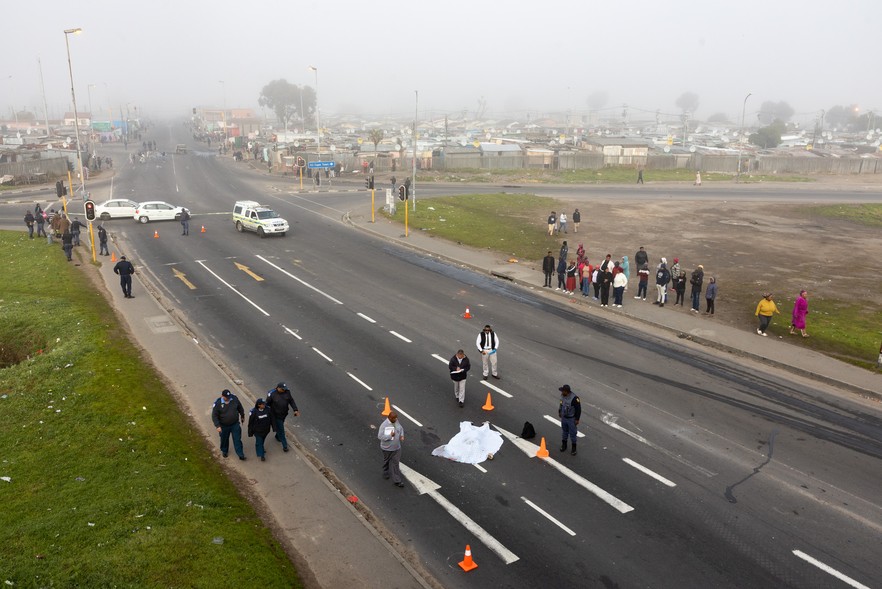Male murder rate is a national health priority, say researchers
Medical Research Council study has looked at why 87% of people murdered in South Africa are men
A man who was murdered lies under a blanket at the N2 and Borcherds Quarry intersection in Cape Town. Archive photo: Ashraf Hendricks
- The vast majority of murder victims in South Africa are men.
- A study by the Medical Research Council has analysed the murders.
- Although men bear the “disproportionate burden” of murders, this has not resulted in “targeted, meaningful prevention” interventions.
A study by researchers at the South African Medical Research Council (MRC) recommends that the muder of men in South Africa deserves an urgent national response.
Richard Matzopoulos of the MRC’s Burden of Disease Unit and his team, which included scientists from the UCT School of Public Health, studied postmortem reports from 2017 to compare murders of women and men. Among the factors looked at were cause of death, age, geographic location and whether alcohol played a role.
The study, published in PLOS Global Public Health, found that 87% of people murdered in 2017 were men. The authors note similar percentages in 2009 (86%) and 2000 (84%).
According to the researchers, this is the first study on male murders in South Africa. Previous studies have focused mainly on femicide (the killing of women). The study focused on 2017 to coincide with the third national femicide study (previous femicide studies were in 2000 and 2009).
The researchers faced challenges getting the paper published in a peer-reviewed journal. Dr Morna Cornell, one of the study’s authors, told GroundUp that men’s health is generally understudied. Cornell believes “we are living in an outdated paradigm which regards all men as powerful and able to navigate health systems etc, and therefore less deserving of care”.
The most common causes of death among male murder victims were sharp stabbings and shootings. For people between the ages of 15 and 44, rates of male murders were more than eight times higher than female murders. The Western Cape has the biggest gap between male and female victims: for every female killed, 11.4 men were killed.
Male murders peaked over December and weekends, suggesting the role alcohol plays.
The study aims to challenge the idea that men are “invulnerable”.
“The fact that men are both perpetrators and victims of homicides masks the strong evidence that men are extremely vulnerable in many contexts,” the study reads.
Murder in South Africa is concentrated in poor neighbourhoods where the effects of poverty and inequality are most significant. According to the study, “violence has been normalised as a frequent feature of civil protest and political discourse”.
High levels of firearm ownership and imprisonment also contribute to violence in South Africa.
“Men are socialised into coping by externalising through anger, irritability, violence against intimate partners and others, and increased engagement in risk-taking behaviours. This, alongside the high levels of violence to which males are exposed across [life], [causes] a continuous, and often intergenerational cycle of violence,” the study says.
While the study acknowledges that “violence against women is endemic in South Africa, with rates almost six times the global figures”, it argues that “men’s disproportionate burden of homicide has not resulted in targeted, meaningful prevention”.
Interventions recommended by the researchers include stricter control of alcohol and firearms, programs to address societal norms that drive physical violence, and efforts to overcome the root causes of poverty and inequality.
Professor Richard Matzopolous, the main author of the study, told GroundUp that more research is needed to understand risks and interventions, especially in a South African context.
“Phase 2 of this study will explore victim/perpetrator and situational contexts,” said Matzopolous.
Next: One child dead and several people injured in Bloemfontein storm
Previous: Workers under Creecy’s “cleaning and greening” project demand unpaid wages
© 2023 GroundUp. This article is licensed under a Creative Commons Attribution-NoDerivatives 4.0 International License.
You may republish this article, so long as you credit the authors and GroundUp, and do not change the text. Please include a link back to the original article.
We put an invisible pixel in the article so that we can count traffic to republishers. All analytics tools are solely on our servers. We do not give our logs to any third party. Logs are deleted after two weeks. We do not use any IP address identifying information except to count regional traffic. We are solely interested in counting hits, not tracking users. If you republish, please do not delete the invisible pixel.



